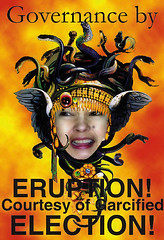To the left, to the left
Bottom Line
By Marvin Bionat
After wreaking havoc as it swung a little too far to the right, the political pendulum is now swinging back to the left. Most Americans have had enough of a government that's too busy doing business as usual as the economy runs amok and then stumbles and crumbles into a heap of despair and anxiety. The question now becomes: How far should the pendulum swing back to the left without leaving a new wreck in its wake?
As the country wallows in the throes of a deep recession, America not surprisingly is more open to a government playing an activist role. Majority (56 percent) approve of the way Obama is handling the economy; compare that to only 31 percent who trust the Republicans to do a better job. For many, there isn't much choice. Extraordinary circumstances require extraordinary measures. It helps that the president is a gifted communicator and is actively selling what his team believes are the right interventions.
Those who have passionately bought into political ideologies (that is, the hard core or the hopeless ideologues) are unlikely to remove their philosophical blinders. In fact, the extreme political right will seize every opportunity to fault the new government for the continuing economic malaise and/or new setbacks. Those on the far left, on the other hand, will be disillusioned as the Obama administration proves itself to be less partisan and more pragmatic in its approach to governance.
Those of us who are more curious students than adamant advocates of political ideologies should pay close attention not so much to the sizzle (and froth) of heated debates (you'll get more than enough of those from listening to talk radio or watching Fox or MSNBC) but to actual evidence.
If the ideological issue is framed in the context of the welfare state (that is, the extent to which the government provides a social safety net to help people), the evidence is readily available. It's just a matter of comparing key indicators in a representative sampling of three kinds of capitalist societies: free market (U.S., Australia, Canada, Ireland, New Zealand, and the U.K.), mixed (Austria, Belgium, France, Germany, Italy, and the Netherlands), and social welfare (Denmark, Finland, Norway, and Sweden). Data is culled from available OECD statistics as cited in Common Wealth: Economics for a Crowded Planet (Jeffrey Sachs, 2008). Overall government spending: At roughly 38 percent of GNP, the free-market governments spend the least. In the middle of the spectrum are mixed economies that spend approximately 49 percent of their national income. Social-welfare states spend the most at 52 percent.
Public-sector outlays: If we break down the data to actual social outlays (cash transfers, direct government provision of services, active labor-market policies), the total public-sector outlays in free-market states are significantly lower at 17.4 percent of GNP (with the U.S. spending even less at 14.8 percent) compared to 25.8 percent and 26.8 percent for mixed and social-welfare economies, respectively.
Key indicators: How does social spending affect the bottom-line indicators (that is, poverty level, inequality, and prosperity)? It turns out that poverty rate in free-market states is much higher at 12.6 percent (and worse in the U.S. at 17.1 percent). Mixed economies do better at 9 percent, and social-welfare states have the lowest poverty rate at only 5.6 percent. In terms of the Gini coefficient (where 0 means wealth is equally distributed, and 100 means distribution is completely unequal), free-market states lag with a coefficient of 32 (35.7 for the U.S.), while mixed economies and social-welfare states do better at 28 and 24.7, respectively.
In terms of technological innovation and R&D spending (key metrics that underlie long-term prosperity), social-welfare states resoundingly trump free-market and mixed economies. Based on the World Economic Forum Technology Index, the average rank among social-welfare states is 6, compared to 16 and 24 for free-market and mixed economies, respectively. Likewise, R&D spending as a share of GNP is much higher at 3 percent in social-welfare states, compared to 1.8 and 2 percent in free-market and mixed economies, respectively.
It should be noted that in this year's list of "Top 10 Happiest Countries" (based on an annual survey conducted by the OECD), Denmark, the quintessential social-welfare state, again tops the list. All the other social-welfare states cited above are also in the top 10, with Finland, Sweden, and Norway taking the second, fourth, and ninth spot, respectively. The U.S. did not make the list.
If the social-welfare states and mixed economies have proven to be much more successful in making their people happy, why doesn't the U.S. learn from them? The political right's mantra of "small government" is certainly a compelling one, but decades of deregulation and tax breaks for the wealthy have brought the economy to the deepest hole since the Great Depression. What then is in the way of a more activist U.S. government?
The race issue: The social-welfare states and mixed economies in Europe are largely racially homogenous, so social programs are met with minimal resistance (that is, it's okay to provide assistance to "their own kind"). In the U.S., because minorities are disproportionately poor, there is a strong resistance to providing assistance to people of different color, putting downward pressure on social spending. This is convincingly proven by the inverse correlation between the size of the African-American population and the level of social spending at the state level; that is, social spending tends to be low in states where there are more African-Americans. The idea of minorities abusing the system and losing the incentive to work fires up ardent right-wing advocates to resist the cyclical swing toward a more social-welfare society, and some are discreet enough to cloak the argument in non-racial terms; for example, as a grossly unfair socialist redistribution.
For political progressives to allow the widest swing to the left, the challenge is to prove or at least successfully argue that social spending is not about cuddling the poor and keeping them dependent on the government, but that government resources can be used to help people help themselves (through the provision of basic services, including affordable housing, health care, and education).
************************************************************************By Marvin Bionat
After wreaking havoc as it swung a little too far to the right, the political pendulum is now swinging back to the left. Most Americans have had enough of a government that's too busy doing business as usual as the economy runs amok and then stumbles and crumbles into a heap of despair and anxiety. The question now becomes: How far should the pendulum swing back to the left without leaving a new wreck in its wake?
As the country wallows in the throes of a deep recession, America not surprisingly is more open to a government playing an activist role. Majority (56 percent) approve of the way Obama is handling the economy; compare that to only 31 percent who trust the Republicans to do a better job. For many, there isn't much choice. Extraordinary circumstances require extraordinary measures. It helps that the president is a gifted communicator and is actively selling what his team believes are the right interventions.
Those who have passionately bought into political ideologies (that is, the hard core or the hopeless ideologues) are unlikely to remove their philosophical blinders. In fact, the extreme political right will seize every opportunity to fault the new government for the continuing economic malaise and/or new setbacks. Those on the far left, on the other hand, will be disillusioned as the Obama administration proves itself to be less partisan and more pragmatic in its approach to governance.
Those of us who are more curious students than adamant advocates of political ideologies should pay close attention not so much to the sizzle (and froth) of heated debates (you'll get more than enough of those from listening to talk radio or watching Fox or MSNBC) but to actual evidence.
If the ideological issue is framed in the context of the welfare state (that is, the extent to which the government provides a social safety net to help people), the evidence is readily available. It's just a matter of comparing key indicators in a representative sampling of three kinds of capitalist societies: free market (U.S., Australia, Canada, Ireland, New Zealand, and the U.K.), mixed (Austria, Belgium, France, Germany, Italy, and the Netherlands), and social welfare (Denmark, Finland, Norway, and Sweden). Data is culled from available OECD statistics as cited in Common Wealth: Economics for a Crowded Planet (Jeffrey Sachs, 2008). Overall government spending: At roughly 38 percent of GNP, the free-market governments spend the least. In the middle of the spectrum are mixed economies that spend approximately 49 percent of their national income. Social-welfare states spend the most at 52 percent.
Public-sector outlays: If we break down the data to actual social outlays (cash transfers, direct government provision of services, active labor-market policies), the total public-sector outlays in free-market states are significantly lower at 17.4 percent of GNP (with the U.S. spending even less at 14.8 percent) compared to 25.8 percent and 26.8 percent for mixed and social-welfare economies, respectively.
Key indicators: How does social spending affect the bottom-line indicators (that is, poverty level, inequality, and prosperity)? It turns out that poverty rate in free-market states is much higher at 12.6 percent (and worse in the U.S. at 17.1 percent). Mixed economies do better at 9 percent, and social-welfare states have the lowest poverty rate at only 5.6 percent. In terms of the Gini coefficient (where 0 means wealth is equally distributed, and 100 means distribution is completely unequal), free-market states lag with a coefficient of 32 (35.7 for the U.S.), while mixed economies and social-welfare states do better at 28 and 24.7, respectively.
In terms of technological innovation and R&D spending (key metrics that underlie long-term prosperity), social-welfare states resoundingly trump free-market and mixed economies. Based on the World Economic Forum Technology Index, the average rank among social-welfare states is 6, compared to 16 and 24 for free-market and mixed economies, respectively. Likewise, R&D spending as a share of GNP is much higher at 3 percent in social-welfare states, compared to 1.8 and 2 percent in free-market and mixed economies, respectively.
It should be noted that in this year's list of "Top 10 Happiest Countries" (based on an annual survey conducted by the OECD), Denmark, the quintessential social-welfare state, again tops the list. All the other social-welfare states cited above are also in the top 10, with Finland, Sweden, and Norway taking the second, fourth, and ninth spot, respectively. The U.S. did not make the list.
If the social-welfare states and mixed economies have proven to be much more successful in making their people happy, why doesn't the U.S. learn from them? The political right's mantra of "small government" is certainly a compelling one, but decades of deregulation and tax breaks for the wealthy have brought the economy to the deepest hole since the Great Depression. What then is in the way of a more activist U.S. government?
The race issue: The social-welfare states and mixed economies in Europe are largely racially homogenous, so social programs are met with minimal resistance (that is, it's okay to provide assistance to "their own kind"). In the U.S., because minorities are disproportionately poor, there is a strong resistance to providing assistance to people of different color, putting downward pressure on social spending. This is convincingly proven by the inverse correlation between the size of the African-American population and the level of social spending at the state level; that is, social spending tends to be low in states where there are more African-Americans. The idea of minorities abusing the system and losing the incentive to work fires up ardent right-wing advocates to resist the cyclical swing toward a more social-welfare society, and some are discreet enough to cloak the argument in non-racial terms; for example, as a grossly unfair socialist redistribution.
For political progressives to allow the widest swing to the left, the challenge is to prove or at least successfully argue that social spending is not about cuddling the poor and keeping them dependent on the government, but that government resources can be used to help people help themselves (through the provision of basic services, including affordable housing, health care, and education).
 Marvin Bionat is the creator of PhilippineUpdate.com, a news and views site that has served as a virtual platform that promotes various advocacies, including the political empowerment of overseas Filipinos and accountability in government. He wrote the National Bookstore bestseller How to Win (or Lose) in Philippine Elections (Anvil Publishing, 1998) and is now based in the
Marvin Bionat is the creator of PhilippineUpdate.com, a news and views site that has served as a virtual platform that promotes various advocacies, including the political empowerment of overseas Filipinos and accountability in government. He wrote the National Bookstore bestseller How to Win (or Lose) in Philippine Elections (Anvil Publishing, 1998) and is now based in the Read more articles by Marvin Bionat
************************************************************************

POGB will not sell, exchange, use or allow any 3rd party access to your email for
any other purposes without exception, email exclusively for article updates only.
























2 Speak Out:
MABUHAY KA MARVIN ! DAKILA KANG PINOY-KANO ! SI KA EDONG PO ITO !
Thanks, Ka Edong. I hope you're well--health and all!
Post a Comment